Every Modern Marvel Event Ranked from Worst to Best
Main Art by Alex Ross, Mark Brooks & Jim Cheung Comics Lists Marvel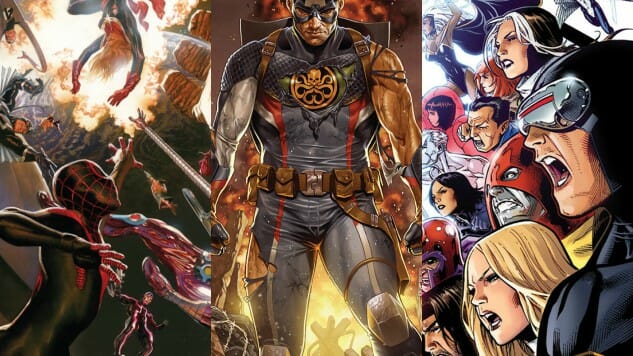
Secret Empire is officially in the can, marking Marvel’s 25th event—by our conservative count—in a little over a decade. Following the undeniable success of early event books like Civil War and House of M, Marvel has made annual (or more frequent!) events a tentpole of its publishing line, reaching a fever pitch over the last few years as events have bled into new cross-title events in a cascade of Russian-nesting-doll comics. What was once a genuinely major meet-up of franchises has now become an expected tide marker of Marvel’s yearly story progression, with events just as likely to result in a satisfying clash of titans as they are to disappoint and derail existing series. Due to the preorder-heavy nature of the direct market, most events are “successful,” at least in the short term, and so remain a standard way for Marvel to ramp up hype, reset storylines, reboot characters and, above all, sell some darn comic books.
In honor of Secret Empire finally concluding after months of controversy regarding its “Nazi Cap” storyline, we revisited our list of Marvel’s modern events to determine where it fell between the best and the worst. To qualify as an “Event,” we determined a story needed a self-named core mini-series as well as tie-ins. This disqualified major sagas like “Messiah Complex” and “Spider-Verse,” which ran through existing titles, as well as limited series like DoomWar and Death of X that didn’t feature tie-in series. We evaluated series on their central storylines, ignoring tie-ins (for good or ill), and on quality of art and writing over impact (or else Civil War would hold the top 10 spots all on its own). Be sure to let us know on Twitter if you disagree.
![]()
 25. AXIS
25. AXIS
Writer: Rick Remender
Artists: Adam Kubert, Leinil Francis Yu, Terry Dodson, Jim Cheung
Does anyone really believe the same guy who wrote Uncanny X-Force, Deadly Class and Tokyo Ghost thought Kluh (read it backwards) was a good idea? Because “Hulk…except kinda like Doomsday, but also funny,” sounds suspiciously like a concept farted out by a merchandising executive who’s never seen the The Itchy & Scratchy & Poochie Show.
Here are the spoilers: In Act One, all the superheroes, and then the villains, fight Red Onslaught (the Red Skull with Xavier’s stolen brain) in a blasting, punching and quipping contest that drags on and on and on. It looks terrible, because Adam Kubert and Leinil Francis Yu draw 38 things happening on every page. Scarlet Witch and Doctor Doom finally defeat Red Onslaught by waving their arms at him. Of course Scarlet Witch can’t order a cup of coffee without causing terrible unforeseen consequences, so her powers make everyone “switch alignments” from good to evil and vice versa. Act Two is superheroes acting like dicks, mostly to the same villains they beat up all the time anyway, and the plot drags on and on and on. In Act Three, Temporarily Nice Carnage throws himself on a bomb to save New York, and in his final moments, announces himself as a proud conservative who loves Lynyrd Skynyrd and the confederate flag. So the moral of AXIS is that even when he’s under a temporary niceness enchantment, Carnage is still a racist. Barry Thompson
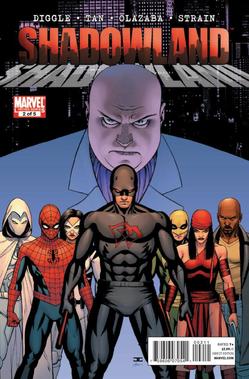 24. Shadowland
24. Shadowland
Writer: Andy Diggle
Artist: Billy Tan
It’s a shame that Shadowland is so irredeemably bad, because its general premise—a street-level war featuring Daredevil, The Hand, Spider-Man, Luke Cage, Iron Fist and a whole bunch of other heroes—is actually quite good.
Shadowland begins with Daredevil in control of resurrection-happy ninja clan The Hand, which is uncharacteristic for the Man Without Fear, but not necessarily cause for concern on its own, except for the fact that he’s now rocking all-black duds. Daredevil also wants to build a base of operations (including a private prison) in the middle of Hell’s Kitchen, right where Bullseye blew up a building filled with people. Okay sure. But then ol’ Hornhead takes things way too far and actually murders Bullseye, in a manner similar to the way Bullseye famously killed Elektra back in the day. That’s when the street-level heroes step in to put a stop to Daredevil’s machinations.
Even before his Netflix stardom, there was little chance Marvel was going to turn Daredevil into a full-on villain, and so Shadowland relies on a hammy mechanism in order for all of Daredevil’s actions to be absolved by the end of the story. If you’re aware of the fall of Green Lantern Hal Jordan in the ‘90s and his return in Green Lantern: Rebirth years later, well then this whole Shadowland thing might seem a little too familiar, and it doesn’t help that Andy Diggle’s writing here is flavorless, and Billy Tan’s art is serviceable but uninspired.
A silver lining shines through on these duds, though. If it wasn’t for Shadowland, which brings Daredevil down to one of the lowest points in the history of the character (and that’s saying something), we would probably not have gotten the historic Daredevil run from Mark Waid, Paolo Rivera, Chris Samnee and Marcos Martin. That series was a serious reaction to and course correction for Diggle’s depressing run and Shadowland. Even Daredevil has to crack a smile once in a while. Jakob Free
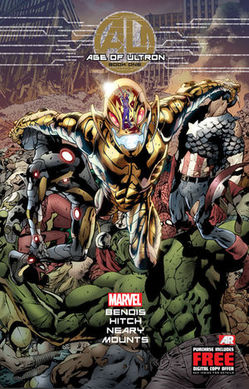 23. Age of Ultron
23. Age of Ultron
Writer: Brian Michael Bendis
Artists: Bryan Hitch, Brandon Peterson, Carlos Pacheco, Others
Hopefully, Marvel forced Bendis and co. to grind this one out because Joss Whedon had already decided on the title for the second Avengers movie, and it needed a precedent in the comics for some arcane trademark purpose. Otherwise, there’s no reason whatsoever why this Days of Future Past Xerox ever needed to exist. Every idea within has been done before and better.
You know the drill—giant robots who shoot lasers out of their faces (this time an army of Ultrons) obliterate human civilization, kill off a sizeable chunk of the superhero community and either Kitty Pryde or Wolverine zips back in time to redirect the course of history and avert The Mean Robot Apocalypse. Not only is that the same premise as one of the most famous X-Men stories ever—one which 20th Century Fox was adapting into a film at the time, incidentally—it’s also the same plot as the Terminator series, one of the highest-grossing action franchises of all time. And if there’s a new or interesting way to present bleak, urban devastation, Bryan Hitch didn’t figure it out in time to draw this comic, and neither did Brandon Peterson and Carlos Pacheco, who were called in after Hitch completed his portion of the book. Barry Thompson
 22. Secret Empire
22. Secret Empire
Writer: Nick Spencer
Artists: Steve McNiven, Rod Reis, Andrea Sorrentino, Leinil Francis Yu, Daniel Acuña, Others
Was Secret Empire worth the yearlong cycle of contentious publicity and accusations that Marvel and writer Nick Spencer indelicately handled Nazi-reminiscent plots at a time when actual incidents of Nazi violence are on the rise in the United States? No, it’s hard to say that it was. Despite pleas by Marvel for readers to read all of Secret Empire before judging it, and assurances from Spencer and Marvel editors that the book wouldn’t end with Cosmic Cube shenanigans, that’s exactly what happened, as anthropomorphic plot device Kobik, a sentient Cosmic Cube, essentially loads up an earlier save file of the virtuous Steve Rogers to go toe-to-toe with his fascist counterpart. Kobik similarly undoes Hydra’s takeover of America, including the deaths of Black Widow and longtime Avengers sidekick Rick Jones. Poor Sam Wilson is reduced to confirming Steve Rogers as the one true Captain America, even though Rogers is also the villain of this piece.
Spencer excels at snappy humor—his characterization of Ant-Man works even amidst this sound and fury—but his overwrought attempts at gravitas fall flat, particularly during the final fight narration that confirms that, yes, punching bad guys is good. Art chores are split between a squad of talented artists, but Andrea Sorrentino is a world away, stylistically, from Daniel Acuña, who clashes with Steve McNiven, and so on, resulting in an utter lack of coherent visual identity. If Civil War II felt like Marvel’s event nadir, Secret Empire is their “hold my beer” moment. The overlong train wreck taints an icon at a time when readers need him to shine brightest, and uses grand, controversial themes to signify almost nothing at all. Steve Foxe
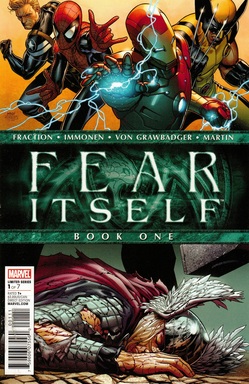 21. Fear Itself
21. Fear Itself
Writer: Matt Fraction
Artist: Stuart Immonen
Unfortunately, comic book writers have a habit of deploying the “secret [sibling/relative/spouse] you didn’t know about until just this very moment” technique too often for my personal tastes. (I’m looking at you Scott Snyder, and your little Lincoln March, too.) But Fear Itself may present the most egregious use of this ploy yet, which is a real bummer because Stuart Immonen is one of the greatest living sequential artists.
Odin has a brother, right? And he’s the total opposite of Odin. And you know how Thor has a magic hammer? This guy has seven magic hammers, which he gives to a who’s who of villains (and a few heroes) like Grey Gargoyle and Crusher Creel. These new hammer-wielders become “The Worthy,” totally extreme action-figure versions of themselves, with names like Mokk: Breaker of Faith and Angrir: Breaker of Souls. In an effort to combat these supervillains, Tony Stark, the infamous drunkard capitalist, unites a bunch of the magical metal used in the production of magic hammers, called Uru, and puts together a suite of action-figure accessories for his buddies. It’s at this point in the story that Matt Fraction realized this miniseries only had seven issues (one issue per hammer?) and not eight, so the book kind of just ends. It has no lasting impact on the Marvel Universe (Thor was “dead” for about a week), its characters or the mind of the reader. But it did have a whole lot of hammers. Jakob Free
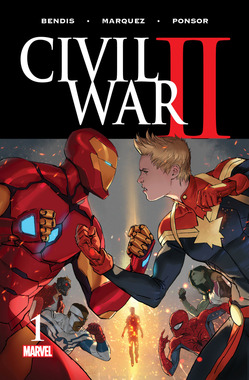 20. Civil War II
20. Civil War II
Writer: Brian Michael Bendis
Artist: David Marquez
Civil War II is a near-perfect study in everything fans don’t want from events: a transparent cash-grab that relies on a contrived deus ex machina, forces heroes against heroes, offs beloved secondary characters, twists other heroes drastically out of established character, derails the publishing line with tie-ins and ships late. Aside from allowing David Marquez time to complete the full series with his slick, clean line work, it’s hard to say that Marvel did anything right in this poorly conceived attempt at capitalizing on the Captain America: Civil War film. Ostensibly about the nature of free will, Civil War II sees Captain Marvel, soon to become Marvel’s first cinematic woman lead, hell-bent on Minority Report-style preemptive policing, rather than due process. Bendis, now coasting on event fumes after too many years crafting mega-stories, jettisons every ounce of goodwill that writers like Kelly Sue DeConnick earned for Carol Danvers, just in time for Marvel to attempt to prime the character for the spotlight. One of Marvel’s most prominent black characters is killed to offer Captain Marvel additional pathos, and one of the publisher’s biggest (literally) icons gets an arrow through the skull. For the sake of every god in the Marvel pantheon, let this mistake of a series be forgotten. Steve Foxe
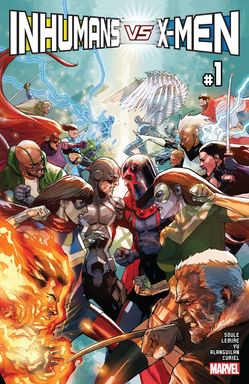 19. Inhumans vs. X-Men
19. Inhumans vs. X-Men
Writers: Jeff Lemire & Charles Soule
Artists: Leinil Francis Yu, Javier Garron, Kenneth Rocafort
It’s a peculiar time to be a Marvel fan attuned to social justice or wider cultural issues as reflected in fiction. Secret Empire hinges on a long-simmering fascist takeover led by a Hydra-affiliated Captain America, and IvX, which recently concluded and relaunched the X-Men and Inhumans books, was an all-out race war undone in its final issue by the sole reasonable character on either side of the conflict flat-out saying, “Why didn’t you just ask?” Looking at the long arc of Marvel events, IvX stands as a final nail in the coffin of a certain extremist take on the X-Men, from pushing hard to euthanize the Scarlet Witch in House of M to being willing to declare war on the Inhumans rather than attempt a peaceable compromise.
Jeff Lemire, whose time on Extraordinary X-Men was an unusually weak showing for the prodigious writer/artist, portrayed the mutants as reactionary and hasty, with nearly every member of the sprawling Xavier family ready to throw down over species lines. Rotating artists Leinil Francis Yu and Javier Garron turned in underwhelming and passable work, respectively, but IvX is little more than a whimpering epitaph for an era during which fans were convinced Marvel was trying to tank the X-Men (whose film rights are controlled by Fox) to bolster the Inhumans (fully owned by Marvel). While the now-booming X-corner of the Marvel U. helps to dispel that rumor, there are few books that sacrifice the X-Men in favor of Medusa and her crew quite so blatantly as IvX. Steve Foxe
 18. Avengers vs. X-Men
18. Avengers vs. X-Men
Writers: Brian Michael Bendis, Matt Fraction, Jason Aaron, Ed Brubaker, Jonathan Hickman
Artists: John Romita Jr., Olivier Coipel, Adam Kubert, Frank Cho
Comic companies have a history of learning the wrong lessons from their successes and failures. Whether you like it or not, Marvel’s Civil War was a huge win for the publisher at the time of its release and remains a perennial seller. What’s the takeaway there? One way to look at it is that fans loves to see their favorite heroes fight one another. And apparently the reason for their fisticuffs doesn’t have to be a particularly good one.
AvX is the logical conclusion of the relentless event generation we’ve been caught up in during this last decade. It is literally [Intellectual Property] versus [Intellectual Property]. The crazy thing about this book is just how damn long it is. With a plot simple enough to be its own title, four or five issues would seem apt to cover this scope of story. The Phoenix Force is coming to town again and, for whatever reason, it’s gunning for deus ex machina of the week Hope Summers. Captain America and the Avengers want to put her into protective custody, but Cyclops isn’t having any of that. A literal war, drawn capably by a team of Marvel heavy hitters, ensues because of this disagreement. So why is this series 12 issues long? When you hire five writers to come up with one story, everyone has to get a few licks in. Jakob Free
 17. House of M
17. House of M
Writer: Brian Michael Bendis
Artist: Olivier Coipel
Even if the Marvel bullpen partially intended House of M as a pretext for erasing prominent aspects of Grant Morrison’s New X-Men, at least it respected the cult icon enough to undo his work in the most spectacular fashion possible. Whilst debating the pros and cons of offing an unhinged and omnipotent Scarlet Witch, the X-Men and Avengers abruptly wake up on a reimagined Earth where most of them live idyllic, wish-fulfillment fantasy lives. Suddenly Magneto—now going by “Lord Magnus”—presides as head of state over a semi-fascist, mutant-supremacist society! Uncle Ben and Gwen Stacy aren’t dead, and Spider-Man is a beloved celebrity! Wolverine remembers his childhood! Steve Rogers is a…useless old man? Kitty Pryde teaches middle school? Luke Cage is a quasi-criminal?
At least the mid-‘00s version of Bendis makes up for holes in the execution of House of M with his mastery of dialogue and characterization. Two scenes in particular—Wolverine’s rooftop pep talk with a soul-broken Spider-Man, and a casual chat between Scarlet Witch and Doctor Strange that takes a disturbing turn—belong on Bendis’ greatest hits compilation. Cover artist Esad Ribic establishes a dreamlike quality that Olivier Coipel’s slick pencils and occasionally confusing layouts don’t quite follow through on, but overall, the art does what it needs to do.
In hindsight, X-Men fans may have lashed out at House of M too hastily. Scarlet Witch’s infamous three-word, event-defining decree feels a lot less upsetting now that we know she (and Marvel) didn’t mean it quite so literally. Barry Thompson
 16. Infinity
16. Infinity
Writer: Jonathan Hickman
Artists: Jim Cheung, Jerome Opeña, Dustin Weaver
Infinity suffers on this list largely because of its unusual structure. Plenty of these events make the most sense only if read in tandem with key tie-ins—House of M’s most poignant plot points happen in other books—but Infinity fully requires the reader to follow along with Hickman’s Avengers and New Avengers. The six-issue space war also serves too many masters. For as purely cool as Thanos’ Black Order looks and acts, they’re ostensibly not the biggest danger here, as the ancient extraterrestrial Builders and fallout from Age of Ultron help incite intergalactic conflict with Earth in the crosshairs. Infinity also sets up the “Inhumanity” storyline, in which Black Bolt unleashes the transformative Terrigen Mists across the globe to mass-ignite his dormant species…and unknowingly threatens mutantkind in the process. Ultimately, Infinity, as gorgeous as it is thanks to the dream team of Jim Cheung, Jerome Opeña and Dustin Weaver, is a midpoint in Hickman’s grand saga and in the arc of Marvel events, and not a story that can stand on its own superheroic legs. Steve Foxe
 15. Siege
15. Siege
Writer: Brian Michael Bendis
Artist: Olivier Coipel
Or, “Brian Michael Bendis Does Passover.”
Siege isn’t bad—some might say it’s even good. It’s four issues long, so it doesn’t overstay its welcome. It has one artist and one writer, so it feels consistent and competently produced. And it caps off Dark Reign, which was a year-long, villain-dominated storyline that spanned the entire Marvel Universe, and was also pretty damn good.
After firing the shot that ended the Secret Invasion, Norman Osborn (yes, the unhinged Spider-Man villain) gets promoted to the head of S.H.I.E.L.D., turns the world police organization into H.A.M.M.E.R. (an acronym that’s never sufficiently explained), sets up a secret cabal with Doctor Doom, Emma Frost, Namor, Loki and the Hood, and goes to town on the Marvel Universe. In an effort to rule the whole planet or whatever, Norman sets his sights on Asgard, which is at this moment in time floating over Broxton, Oklahoma (long story). He sics his Dark Avengers (a bunch of bad guys dressed up as good guys) on the fabled Norse city and the real superheroes intervene. Punch, kick and then the Sentry (Marvel’s dubiously sane Superman analogue) reveals himself to be the actual Angel of Death. It’s quite bizarre, as writer Brian Michael Bendis actually used the story of Passover from the Old Testament as grist for the Sentry’s transformation—who, for some reason, becomes a sort of crab monster. Eventually the heroes win the day, everyone who isn’t dead goes to jail, and the line moves onto the Heroic Age. Jakob Free
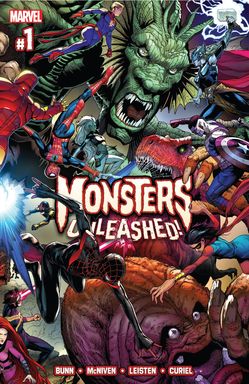 14. Monsters Unleashed
14. Monsters Unleashed
Writer: Cullen Bunn
Artists: Adam Kubert, Greg Land, Salvador Larroca, Steve McNiven, Leinil Francis Yu
Monsters Unleashed is—Groot forgive us—an odd beast of an event. It doesn’t attempt to change the status quo (beyond introducing a new kaiju-creating preteen Inhuman) and its tie-ins were restricted to “.MU” issues, most by rising talent, that didn’t disrupt existing series. Cullen Bunn has done reliably good (if rarely great) work for Marvel, and the rotating art team of Steve McNiven, Adam Kubert, Greg Land, Salvador Larroca and Leinil Francis Yu meant the book came and went quickly and looked four-fifths great. Monsters Unleashed seems to have taken to heart most criticisms of Marvel’s constant event churn. So what’s the rub? By training readers to expect huge, universe-shaking changes when the “event” banner is trotted out, self-contained series like Monsters Unleashed end up feeling like a symptom of Marvel’s need to constantly have an event running regardless of whether or not a story calls for a tie-in sprawl. MU was further hurt by arriving as the much-maligned Civil War II stumbled to the finish line and the hotly debated Secret Empire revved up. It’s hard to hate on giant monsters, but MU ultimately feels like filler—the opposite of what an “event” should signify. Steve Foxe
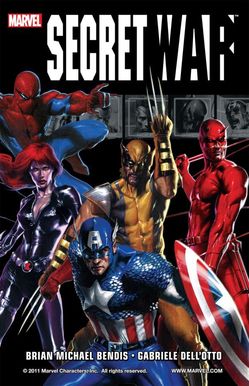 13. Secret War
13. Secret War
Writer: Brian Michael Bendis
Artist: Gabriele Dell’Otto
Flowing from his creative high on Daredevil with Alex Maleev, Brian Michael Bendis gave Marvel its most distilled black-ops opus with Secret War, though the miniseries trades in every shade of grey. These issues feature Nick Fury recruiting and brainwashing a group of Marvel capital-S superheroes to eliminate an Eastern European government arming and funding supervillains in the United States. The target of that mission, Lucia von Bardas, returns to wreak vengeance on New York in the comic book equivalent of this Onion article. The event offers a cooler and more relevant political allegory than Marvel’s other attempts, and Gabriele Dell’Otto, while glacial, still channeled a stately, heavy sense of doom with his digital paints; just look at the scales on Cap’s armor. Bendis nails the ultimate themes of greater goods, deception and how the best scenarios in terror navigation are only slightly less awful than the alternative. While its ending devolves into familiar superhero tropes, Secret War stands as an ambitious and cool footnote in the Marvel mythos. Sean Edgar
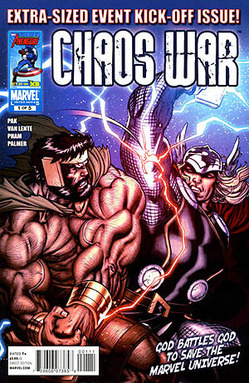 12. Chaos War
12. Chaos War
Writers: Fred Van Lente & Greg Pak
Artist: Khoi Pham
Like many of the cosmic events on this list, Chaos War feels less like a forced event and more like a natural extension of storylines building in ongoing titles—weird how that results in better storytelling. In this case, the ongoing title in question was the often hilarious Hercules, written by Fred Van Lente and Greg Pak. Chaos War, so named for the demonic Chaos King, sees the Greek demigod uniting champions from across Marvel’s various pantheons to stave off the assault of the aforementioned, discord-obsessed deity. Aside from largely concluding the stories of Hercules and his then-sidekick Amadeus Cho (who has since graduated to being the freakin’ Hulk), Chaos War fiddled with the concept of death and allowed the publisher to walk back a few untimely demises, including most of the Canadian hero squad Alpha Flight. Khoi Pham isn’t the strongest penciller to contribute to Pak and Van Lente’s Hercules stories, but his sketchy line ably brought to life gods, goddesses and demons from across Marvel’s various pantheistic religions. Steve Foxe
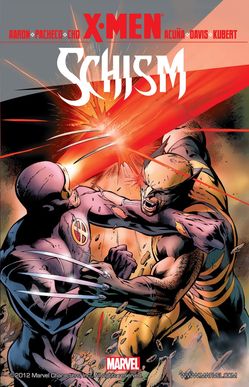 11. X-Men: Schism
11. X-Men: Schism
Writers: Jason Aaron
Artists: Daniel Acuna, Frank Cho, Alan Davis, Adam Kubert, Carlos Pacheco, Others
Any fans disillusioned with the post-military direction of recent X-Men tales can chart their malaise back to X-Men: Schism, which is ironically a very good X-Men miniseries. The titular divide develops between odd couple Cyclops and Wolverine, who reverse type in these five issues: Wolverine advocates for more harmony between mutantkind and humans while Cyclops gets weird and becomes the misguided superhero equivalent of Malcolm X, except not at all. The title would eventually lead to two branches of the X-Men cosmos: Schism writer Jason Aaron would progress to write the optimistic Wolverine and The X-Men, retaining the legacy of softball games, upstate New York mansions and fan-favorite mutant ambassador Kitty Pryde. The other direction would pivot to grimdark extremes with Cyclops training child soldiers in a genetic war where their homebase was an isolated island and then purgatory, because that’s a totally subtle metaphor. Schism straddles those tones with humor and confidence; Aaron’s preference for the book’s winsome nostalgia was evident, and he evolved Wolverine gorgeously into a paternal figure who works tirelessly so other mutants avoid the same fate he’d suffered. It’s an interesting philosophical exploration of how minorities address oppression and where the breaking point of forced violence looms. It’s also an embarrassingly cool facedown between a man with metal claws and another man with laser eyes. Sean Edgar
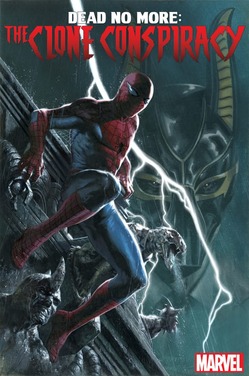 10. Dead No More: The Clone Conspiracy
10. Dead No More: The Clone Conspiracy
Writer: Dan Slott
Artists: Jim Cheung
Dan Slott got a raw deal when we determined the criteria for events. “Spider-Island” and “Spider-Verse” are two of the stronger far-reaching “big” stories from Marvel’s modern history, but each kept its primary plot contained to the pages of Amazing Spider-Man rather than a self-titled event mini-series, a trend bucked by The Clone Conspiracy. There’s no real justification for the shift in approach beyond what was surely an appeal to increased sales. Clone Conspiracy, like “Spider-Verse” and “Spider-Island” before it, webs up the whole Spider-related publishing line but doesn’t stray beyond its arachnid bounds. Slott, with an impressive visual assist from Jim Cheung, returns to one of Peter Parker’s most detested ‘90s storylines: the Clone Saga. Only this time, the Jackal (sporting an excellent visual rebranding) is cloning e’rybody, from dearly departed civilian bystanders to long-dead B-list villains. It’s hardly a spoiler to reveal that the end result brings the original Scarlet Spider, Ben Reilly, back to life—his own solo series is launching soon from Peter David and Mark Bagley—. Suffice to say that Slott has proven time and again to have a solid handle on Parker (even if this event occasionally dips back into his unusually pronounced affection for Doc Ock). Steve Foxe
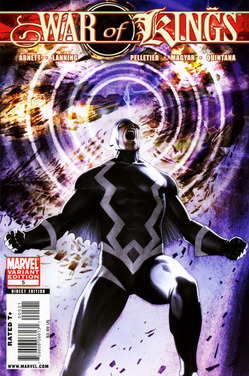 9. War of Kings
9. War of Kings
Writers: Dan Abnett, Andy Lanning, C. B. Cebulski, Christopher Yost
Artists: Paul Pelletier, Harvey Tolibao, Brad Walker, Wellington Alves, Others
Years before they carried the full brunt of multimedia expectations on their backs, the Inhumans—the popular royal family created by Jack Kirby and Stan Lee—were at the center of this cosmic crossover that exists as both a follow-up to the Annihilation sagas as well as a modern-day tribute to the X-Men space stories of the Chris Claremont era. In War of Kings, Vulcan, the long-lost and barely sane third brother of Cyclops and Havok, stages a coup of the birdlike Shi’ar empire and subsequently declares war on the Kree and their superpowered Inhuman rulers. Both Black Bolt and Vulcan, as well as longtime X-ally and Xavier love interest Lilandra, are seemingly killed in the conflict (Black Bolt obviously got better), destabilizing the interstellar balance of power and opening up a rift into a Lovecraftian alternate dimension that would play heavily into subsequent cosmic crossovers. It’s worth noting that the cosmic “Events” stand up so well largely because that corner of the Marvel U. couldn’t sustain many ongoing series—these crossovers were key steps in progressing long-simmering plots. Steve Foxe
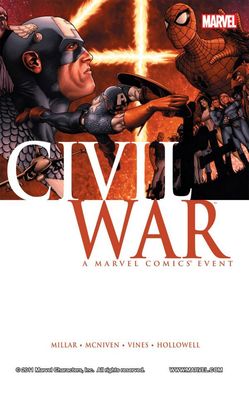 8. Civil War
8. Civil War
Writer: Mark Millar
Artist: Steve McNiven
Mistaking Mark Millar and Steve McNiven’s hero-on-hero action orgy for something politically significant is tempting. The seven-issue series drives a stake through the capes community after Tony Stark introduces legislation that requires superheroes to register with the government. Captain America refuses and assembles a band of rebels to fight the (Iron) Man. But what does this premise actually mean? Is it a reflection on permissive gun laws or an exploration of unilateral WMD policy, a topic that loomed large three years earlier when George W. Bush invaded Iraq to seize warheads that didn’t exist? Millar filibusters around any grand thesis, and instead embraces the escapism of many other Marvel comics event that ended in “War”: this was a chance for the publisher to toss a bunch of action figures in a blender and watch the pretty, shallow chaos unfold around a mirage of socio-political relevancy. Illustrated with fastidious adoration by Steve McNiven and designed with classy, Swiss restraint, it sure as hell looked operatic and important, even if it never scaled a fraction of the heights it promised. Sean Edgar
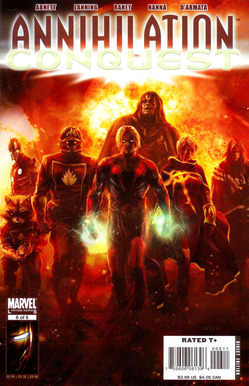 7. Annihilation: Conquest
7. Annihilation: Conquest
Writer: Dan Abnett, Andy Lanning, Keith Giffen, Christos Gage, Javier Grillo-Marxuach
Artists: Tom Raney, Sean Chen, Kyle Hotz, Others
While not as page-by-page strong as its predecessor, it’s hard to imagine the modern landscape of Marvel—comics and beyond—without Annihilation: Conquest, even if it took years for its impact to saturate the publisher. Written and orchestrated by writing duo Dan Abnett and Andy Lanning, Annihilation: Conquest led to the formation of the modern-day Guardians of the Galaxy, captained by an affable former has-been known as Star-Lord. There’s little chance that 2014’s Guardians of the Galaxy film (or its approaching sequel) would exist were it not for the characters’ rebirth under Abnett and Lanning’s stewardship—although those same characters have been almost unrecognizably overhauled in recent years to better match their film iterations. Conquest builds on its precursor series by giving longtime Avengers foe Ultron a new, interstellar plan for domination. Much of Annihilation’s cast returns, alongside an increased profile for Quasar and the resurrection of Adam Warlock. If Annihilation felt like a one-off, Conquest proved that Marvel’s cosmic corner held near-infinite storytelling possibilities. Steve Foxe
 6. World War Hulk
6. World War Hulk
Writer: Greg Pak
Artist: John Romita, Jr.
It’s been nearly a decade since an extremely pissed-off Jade Giant returned to Earth with vengeance on his mind, but expect this tight beat-‘em-up to get renewed attention thanks to its influence on Hulk’s portrayal in the upcoming Thor: Ragnarok. Building directly out of Greg Pak’s “Planet Hulk” storyline, in which a cadre of Marvel heroes decided the green giant was so dangerous they shot him into space, World War Hulk sees the former Avenger return from his time “abroad” battle-hardened and packing a crew of alien gladiator allies. John Romita, Jr. was at his mid-‘00s peak here, with his evolution into a blocky, sketchy style well on its way but still defined enough to make each gamma-powered punch hurt. Pak’s plot has a video-game simplicity to it: Hulk finds hero who wronged him, Hulk punches hero, Hulk moves on. A betrayal on Hulk’s own team eventually gives Earth’s heroes a chance to subdue the irradiated titan, but the damage was done, and Bruce Banner remained on a largely uncomfortable basis with his one-time allies straight through until his demise in the recent Civil War II event. Steve Foxe
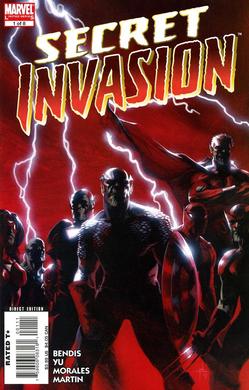 5. Secret Invasion
5. Secret Invasion
Writer: Brian Michael Bendis
Artist: Leinil Francis Yu
As much as “Way, way better than most Marvel events” scans like a backhanded compliment, Secret Invasion genuinely lives up to every connotation of the word “epic.”
With their home world Galactus’d out of existence, the alien Skrulls swap members of influential Earth institutions with shapeshifting spies tasked with greasing the wheels for a planetary takeover. In ill-adept hands, this scenario pans out as The Action Figures vs. The Bad Green Aliens. But Bendis—still on his ‘00s streak of pure fire—arranges and juggles dozens of players with Dickensian precision. Stakes wind up high and personal for virtually all parties involved, even the Skrulls, who, despite their absolute dickweed behavior, don’t see themselves as the bad guys. You might even catch yourself empathizing with the poor, wrinkly, self-determination-resistant slobs before the sufficiently shocking conclusion. Leinil Francis Yu demonstrates a scary capacity for splash pages that remains compelling, even after the fifth or sixth image of capes and Skrulls whomping each other in a single issue.
Today, it’s easy to blame Marvel’s event mongering for its slumping sales. But lest we forget that not even 10 years ago, imprint-spanning, biannual crossovers didn’t look like the obviously stupidest-ever marketing strategy it does now. Barry Thompson
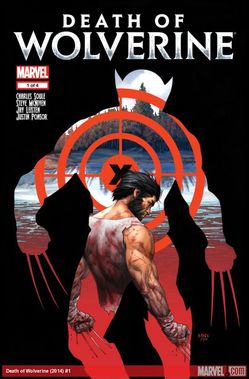 4. Death of Wolverine
4. Death of Wolverine
Writer: Charles Soule
Artist: Steve McNiven
We didn’t intend to include Death of Wolverine on this list. Like Death of X, this four-issue mini-series sendoff to one of Marvel’s most enduring characters felt self-contained…until we remembered that it spawned no fewer than four Death of Wolverine-branded spin-offs as well as tie-ins in several other series (almost all of which were middling at best). But the core storyline—written with surprising emotional depth by Charles Soule and drawn by Steve McNiven just as his ‘90s influences were becoming more visible in his hyper-slick style—is a fitting farewell to the adamantium-laced mutant. Faced with his impending demise after an artificially extended existence of pain, heartbreak and hope, Logan readily gives up what life he has left to make sure the same damage done to him can’t be inflicted on anyone else. Marvel has since repopulated its universe with at least three “other” Wolverines, but there can only be one Logan, and Death of Wolverine did right by him through to its final page. Steve Foxe
 3. Original Sin
3. Original Sin
Writer: Jason Aaron
Artist: Mike Deodato, Jr.
Crossovers, or “Events,” as we have now taken to calling them, once meant that favorite characters from different titles showed up together in the same book. But since crossovers happen every week in nearly every comic, many events have lost the power of their central conceit. Nowadays, we’re assaulted with so many of these large-scale comics, with contrivances as thinly sketched as “one more Civil War for the road” (Civil War II) or “the heroes had another argument” (Inhumans vs X-Men), that they feel less like events and more like Wednesdays.
A good crossover comic does not need the bombast of a Michael Bay movie, nor the complexity of a multi-title, tie-in-smeared, market-saturated reboot. Sometimes a good event requires nothing more than a simple murder mystery and a buddy-cop romp through the astral plane with Doctor Strange and the Punisher. And this is exactly what we get in Jason Aaron and Mike Deodato, Jr.’s Original Sin, which offered a complete story and fertile ground for varied tie-ins.
Someone has murdered Uatu, the cosmic all-seeing Watcher, and the Marvel heroes have to find out who and why. Aaron takes the crossover philosophy back to basics, opting to place characters who wouldn’t normally hang out together in different teams with different objectives. This leads to cheeky exchanges between Rocket Raccoon and the Punisher, or the aforementioned tête-á-tête between the Punisher and Doctor Strange. Jakob Free
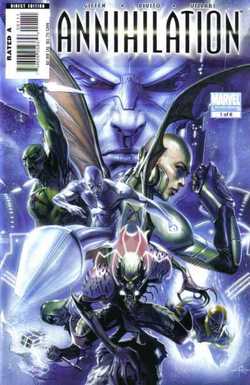 2. Annihilation
2. Annihilation
Writers: Keith Giffen, Dan Abnett, Andy Lanning, Simon Furman, Javier Grillo-Marxuach
Artists: Andrea Di Vito, Renato Arlem, Jorge Lucas, Kev Walker, Others
Keith Giffen has been a DC mainstay in recent years, but Marvel owes him a great debt for knocking over the dominos that resurrected dormant cosmic characters and gave then-outdated properties like the Nova a modern spin. Told across a central series and four mini-series, Annihilation channeled the best of Jim Starlin’s ‘80s and ‘90s interstellar sagas into space-based action accessible enough to invite a new generation of readers to reach for the stars. While Annihilation’s sequel, subtitled Conquest, focused on a more ragtag band of characters, this first saga was all about the heavy hitters: Drax, Silver Surfer, the Super Skrull and the big boy himself, Galactus, all united against the overwhelming might of Annihilus’ ravenous alien insect hordes. Annihilation is an early entry in the modern Marvel event canon, and by virtue of its trailblazing status, avoided most of the associated pratfalls. The story is tight and well paced, and the tie-ins inform aspects of the central plot that better the reader’s overall understanding of the action and character motivation. If only more events had followed in its epic, yet self-contained, footsteps. Steve Foxe
 1. Secret Wars
1. Secret Wars
Writer: Jonathan Hickman
Artist: Esad Ribic
While it’s easy to talk about “event fatigue” and both Marvel and DC’s reliance on nonstop event-comic buildup and fallout, the nuance missing from that criticism is that readers aren’t opposed to big stories, but to the often-subpar execution. In too many events on this list, the inciting incidents feel contrived and the characterization of popular faces goes out the window to service the status-quo-refiguring “plot.” Jonathan Hickman and Esad Ribic’s grand treaty, Secret Wars, is the largest-scale event comic Marvel has published since House of M, but it’s also one born out of half a decade of careful planning, from the Council of Reeds in Fantastic Four to the intergalactic interference of Infinity to the treacherous decisions of the Illuminati in New Avengers. The stunningly illustrated nine-issue epic not only pressed the soft reset button on the entire Marvel Universe, uniting the salvageable elements of the Ultimate Universe with the core 616, it also closed the door on all of Hickman’s Marvel work up to that point. The mic-drop comic rewarded the writer’s longtime readers with a poignant and powerful arc for the Richards family and Doctor Doom, perhaps one of the most complicated characters in Marvel’s stable thanks to Hickman’s deft handling. Secret Wars warped reality without ever losing sight of what matters most in superhero storytelling, even at the event scale: character. Steve Foxe